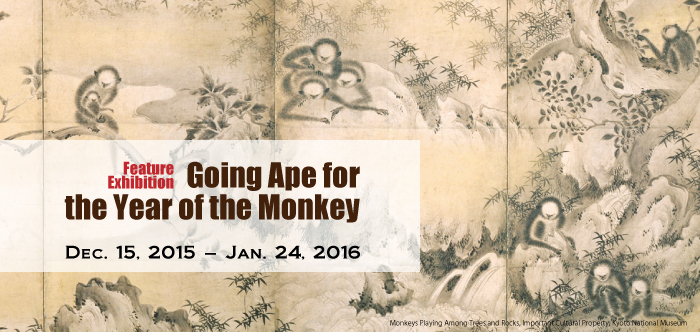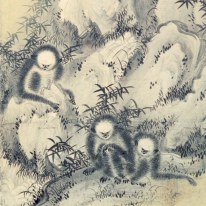General Information
| Exhibition Title | Going Ape for the Year of the Monkey |
|---|---|
| Period | December 15, 2015 - January 24, 2016 |
| Venue | Heisei Chishinkan Wing (The Collections Galleries) |
| Transportation | JR, Kintetsu Railway, Keihan Railway, Hankyu Railway, City Bus / Map |
| Closed | Closed on Monday *When Monday is a national holiday, the museum will be opened on Monday and closed on Tuesday. Dec. 26, 2015 - Jan. 1, 2016. |
| Museum Hours | 9:30 a.m.-5:00 p.m. (Entrance Until 4:30 p.m.) |
| Admission |
Adult 520 yen (410 yen) Univ. Student 260 yen (210 yen) (Fees in parentheses are for groups of 20+) *Admission is free for youths of high school age and below. |
Images from the Exhibit
2016 is the Year of the Monkey according to the Chinese Zodiac. This zodiac system, which is also used in Japan and other places in Asia, features a cycle of twelve animals. In honor of the Year of the Monkey, the Kyoto National Museum is bringing out a variety of paintings and decorative art objects with representations of this zodiac animal.
The most frequently seen monkey in Japan is the indigenous Japanese macaque (nihonzaru). With their pink faces, grey-brown fur, and short tails, macaques are instantly recognizable, appearing in various forms of traditional Japanese culture. In the mid Edo period (1615–1868), such illustrious artists as Itō Jakuchū (1716–1800) and Soga Shōhaku (1730-1781) painted these monkeys with idiosyncratic charm. Works by Mori Sosen (1747-1821), the renowned master of macaque painting, are a special highlight of this exhibition.
Another kind of "monkey" found in Japanese and Chinese art is the gibbon (tenagazaru), which is actually a kind of long-armed, long-legged ape. Though indigenous to China, South Asia, and Southeast Asia, it became a common subject matter in medieval Japanese ink painting.
Also on view are handscrolls featuring monkey characters, lacquered netsuke (decorative toggles) with extraordinary monkey designs, and other works from Japan and China showing the prevalence of this creature in East Asian culture.













